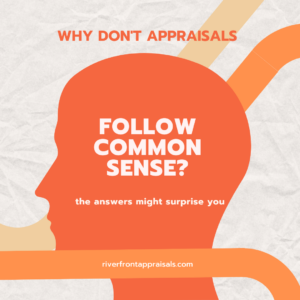
Property Taxes Just Went Up? We’ve Got You Covered!
It’s reassessment season for most folks in our area. Homeowners

Welcome to your crash course in choosing comps. In this blog post, we’ll discuss the various methods for choosing comparable sales, just the way an appraiser does.
When pricing a new listing, you’ll first gather all the information about the home and neighborhood. While that may take some time to collect, that’s the easy part. The hard part comes next, when you search for sales that may support your list price, and (most importantly) the final sale price.
And, try as you may to get the best sales available, no matter which sales you choose, the appraiser may choose other sales to use in the appraisal for comparable sales. And they may or may not support your value. So wouldn’t it be nice to know how an appraiser chooses sales when completing an appraisal?
With the information presented in this blog post, you’ll grow in your understanding of the appraiser’s process for comparable sale selection, which helps you in pricing your next listing.
We’ll begin by defining two key terms you’ll want to know: Highest and Best Use; and Substitution. The following aren’t official textbook definitions, but my own definitions.
Highest and Best Use is that use of vacant or improved land that is physically possible, legally permissible, financially feasible and maximally productive. When choosing comparable sales, all sales need to have the same Highest and Best Use (HBU) and all need to be similar to that of the subject. This means that if you are listing a single family residence, you wouldn’t want to compare it to a home that’s zoned commercial and being used as a medical office. Or, if you’re listing 20 acres of prime land that would be perfect for a new residential development, you shouldn’t also look at a smaller five acre site suitable for only a single family residence.
Substitution asks the question “would a buyer have considered these homes in their search, if they were listed at the same time as my listing?” When looking for sales to compare your new listing to, try and stay as similar as possible, and keep buyer’s actions and preferences top of mind. If you have a four bedroom, two bath 3,200 square foot home, would buyers also look at a two bedroom, one bath 1,500 square foot home? Not likely.
Also, make sure you’re not over-pricing your listing. Using the principle of substitution, you can determine what buyers were willing to pay for a home similar to yours. If you find a sale that’s a model match for your 3,200 square foot home and it sold for $375,000, then it’s not likely your listing will sell for much more, unless you’re in an area with rapidly increasing market values.
Now that we have a few key terms under our belt, let’s look at what Fannie Mae has to say in their Selling Guide. This is perhaps the most extensive resource available on a number of topics, so most of what you read below is taken straight from the Selling Guide, with a few of my comments added for clarification. We’ll cover what makes a comparable sale, distance and age requirements, and the challenge of new construction sales.
What Makes a Sale a Comparable Sale?
Fannie Mae states that “Comparable sales should have similar physical and legal characteristics when compared to the subject property. These characteristics include, but are not limited to, site, room count, gross living area, style, and condition. This does not mean that the comparable must be identical to the subject property, but it should be competitive and appeal to the same market participants that would also consider purchasing the subject property” (there’s that principle of Substitution).
How old can the comparable sales be?
Let’s dispel a couple of myths, right off the bat, shall we? In various forums and groups, I often read “Oh, comps have to be less than 90 days old…or comps can’t be more than six months old.” Neither of these are true, with one exception. FHA requires two sales within 90 days in markets with increasing or decreasing market values. But that’s it. Although some banks like to add additional stipulations, there’s no other requirement than what Fannie Mae states below:
“Comparable sales that have closed within the last 12 months should be used in the appraisal; however, the best and most appropriate comparable sales may not always be the most recent sales. For example, it may be appropriate for the appraiser to use a nine month old sale with a time adjustment rather than a one month old sale that requires multiple adjustments.”
“Additionally, older comparable sales that are the best indicator of value for the subject property can be used if appropriate. For example, if the subject property is located in a rural area that has minimal sales activity, the appraiser may not be able to locate 3 truly comparable sales that sold in the last 12 months. In this case, the appraiser may use older comparable sales as long as he or she explains why they are being used.”
So keep your search to sales that are as new as possible, especially in increasing / decreasing markets. From there, try to stay within 12 months, but if absolutely necessary, you can expand that as well.
How far away can I search for sales?
Regarding distance, there is no written requirement that sales must be one mile or five miles from the subject property. However, as we all know, location is incredibly important when selecting sales, so you need to stay as close to the subject as possible. Most lenders add their own expectations to appraisers, and you should be aware of those. Again, while not a written requirement, most lenders want to see comps less than a mile from the subject in urban areas, less than two miles for suburban markets, and no more than five miles away in rural neighborhoods. This isn’t always possible to achieve, and when those distance recommendations are exceeded, the appraiser simply states why, and if it affects value in any way.
Here’s what Fannie Mae says about distance:
“Comparable sales from within the same neighborhood (including subdivision or project) as the subject property should be used when possible…”
“Fannie Mae does allow for the use of comparable sales that are located in competing neighborhoods, as these may simply be the best comparables available and the most appropriate for the appraiser’s analysis.”
Note there’s no ‘comparable sales must be located no more than one mile from the subject property’ language from Fannie Mae.
How to find comparable sales for a new home
Appraisers have an added challenge when looking for comparable sales of new homes. In tract subdivisions it may not be quite as difficult, but in rural markets, it is often very challenging. Most new homes in rural markets are custom-built homes, built on land owned by the homeowner prior to the home being built. These homes aren’t acceptable to be used as comparable sales. Fannie Mae states that we cannot ‘create’ comparable sales by combining sales of vacant land with the contract purchase price of a home (which would include the improvements only).
In addition to all the criteria we’ve already discussed, for new construction in a developing neighborhood, we have to take it one step further. We must include at least one sale from within the subject’s neighborhood and one from outside the neighborhood. The way I like to meet this guideline is to include three sales from within the subject’s neighborhood (when possible), and then include a fourth or fifth sale outside the neighborhood, to prove marketability and value of a similar property outside the influence of the subject’s builder.
What happens when there aren’t any comps?
Fannie Mae says “If a property is located in an area in which there is a shortage of truly comparable sales, either because of the nature of the property improvements or the relatively low number of sales transactions in the neighborhood, the appraiser might need to use properties that are not truly comparable to the subject property. In some situations, sales of properties that are not truly comparable may simply be the best available and the most appropriate for the appraiser’s analysis.”
This isn’t likely to happen too often, but just remember it’s acceptable. First, exhaust all the more recent and relevant sales information possible. And if you just come up empty, or with very few sales, go on and look at sales that aren’t truly comparable and make necessary adjustments.
Bringing it all together
Ok. So you’ve just gotten a crash course in how to choose comps, what criteria to use, Fannie Mae guidelines, and more. What now? How do you take all of this and put it to work? Here’s my technique. While every appraiser will vary slightly, most appraisers work the same way, and you can too.
Imagine a funnel. At the top of the funnel are all the sales in your market. There’s a lot, I know. What you want to do is begin searching for sales that are similar to your subject, and by the end of the process, at the bottom of the funnel, you’ll have 3, 4, maybe 6 sales that are good substitutes – truly comparable homes that you can use in pricing your new listing.
For this example, we’ll use the following property:
A three bedroom, two bath Cape Cod-style home with 2,400 square feet plus a 1,600 square foot finished basement. The home is located in a suburban neighborhood just a mile from the city center. It was built in 2005 and remodeled in 2020, is situated on a ½ acre lot and includes a two-car attached garage, covered porch and rear patio. It last sold a few years ago (after the renovation) for $250,000.
First, let’s start with location. Since we’re in a suburban neighborhood, I suggest searching for sales within a radius of two miles. Then, set your date of sale parameters to 12 months. You know the home sold for 250k just a few years ago, and the market hasn’t declined, so that’s a good starting point. If the market has been stable, maybe your price range you want to start with is $200,000 – $400,000. It’s a wide range, but we’ll narrow it down. If you can search by square footage, set your range to between 1,500 – 3,500 square feet. Every time you set new criteria, you are narrowing down the number of sales.
Let’s say that after you set all of these, you’re left with 20 sales. From here, you probably need to cut this list in half, so start with the same criteria and start narrowing them down. Get rid of anything located over a mile from the subject. Kick out sales over six months old. You’re getting close! From here, consider getting rid of anything that doesn’t have a basement, or that maybe hasn’t been remodeled. By this time, you’re likely left with only a few sales, and they should all be truly comparable to your subject.
If for some reason your initial search only turns up two or three potential sales, then consider going the opposite direction, and expanding your search criteria. Expand your distance guidelines another mile, but keep the date set to 12 months. If this doesn’t produce more sales, increase the date to 18 months. Consider sales that haven’t been updated, or that don’t have a basement, or perhaps older homes.
Having a solid understanding of how appraisers search for comparable sales will help you the next time you go on the hunt for comps for your new listing. And, when you land that hard-to-comp listing, you now have a few new tools to use and a better understanding of what an appraiser will do when it comes time for the appraisal.
Committed to helping you understand your home’s market value,
Ryan Bays, SRA, AI-RRS

It’s reassessment season for most folks in our area. Homeowners

I feel like we all need a laugh. How about

So this may be a slight break from the norm,
Riverfront Appraisals has been providing comprehensive valuations of residential properties to Western Kentucky and Southwestern Indiana since 2008.